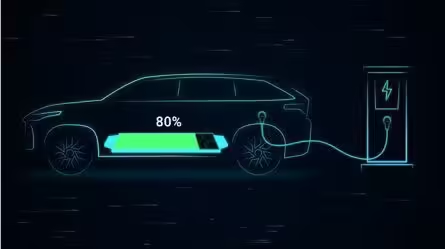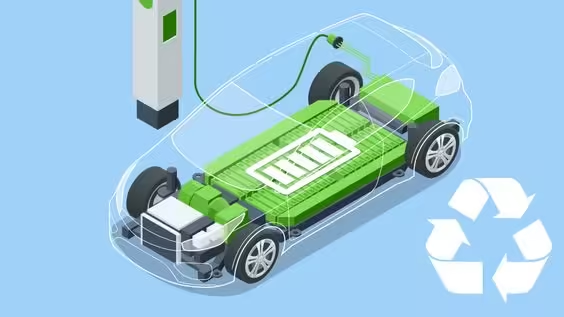
As the world shifts towards cleaner energy and transportation, electric vehicles (EVs) are at the forefront of the fight against climate change. With zero tailpipe emissions and growing renewable energy adoption, EVs promise a greener future. However, one challenge often overlooked in the sustainability narrative is the lifecycle of lithium-ion batteries, the backbone of EV technology. These batteries, while key to EV performance, pose significant environmental concerns, particularly when they reach the end of their lifespan. Recycling and sustainable management of these batteries is crucial to ensuring that the green promise of EVs holds true.

In this blog post, we’ll delve into the environmental impact of lithium-ion batteries, the challenges of battery recycling, and the exciting innovations shaping the future of sustainable battery management.
1. The Environmental Challenge of Lithium-Ion Batteries
Lithium-ion batteries are widely used in electric vehicles due to their high energy density, relatively long life cycle, and ability to charge quickly. However, their production involves mining rare minerals, including lithium, cobalt, nickel, and manganese, which can have significant environmental and social implications.
Resource extraction:
- Lithium mining: The extraction of lithium, primarily from salt flats in South America, requires large amounts of water, often in water-scarce regions. This can lead to ecosystem disruption and water shortages for local communities.
- Cobalt mining: Much of the world’s cobalt supply comes from the Democratic Republic of Congo (DRC), where mining operations have been linked to child labor, hazardous working conditions, and severe environmental degradation.
The environmental costs don’t stop at resource extraction. The manufacturing of lithium-ion batteries is energy-intensive, often relying on fossil fuels, especially in countries like China, where coal-powered electricity dominates. Without proper recycling, the discarded batteries risk piling up in landfills, leading to potential soil and water contamination from hazardous chemicals like lead and acid.
Key takeaway:
- The production and disposal of lithium-ion batteries have notable environmental and social impacts. Sustainable battery management is critical to addressing these challenges.
2. The Importance of Recycling Lithium-Ion Batteries
With millions of EVs on the road and global EV adoption accelerating, the world is facing an impending surge in battery waste. Lithium-ion batteries typically last between 8 to 15 years in electric vehicles, but what happens when these batteries reach the end of their useful life? Without recycling, they could contribute to significant environmental damage.
Recycling lithium-ion batteries offers several benefits:
- Reduces the need for new resource extraction: Recycling recovers valuable metals like lithium, cobalt, and nickel, reducing the need for additional mining, thus preserving natural resources and limiting environmental degradation.
- Decreases waste and pollution: Improper disposal of lithium-ion batteries can result in toxic chemicals leaking into the environment. Recycling prevents these harmful substances from contaminating soil and water sources.
- Supports the circular economy: By recycling old batteries and reusing materials, the industry can create a more sustainable and closed-loop system, reducing the environmental impact of battery production and disposal.
Recycling can also mitigate supply chain risks for EV manufacturers. As demand for EVs grows, so does the demand for key battery components, which are already subject to price fluctuations and geopolitical uncertainties. A robust recycling industry can help secure a steady supply of these materials, lessening reliance on volatile markets.

Key takeaway:
- Recycling lithium-ion batteries reduces environmental harm, lowers the need for raw material extraction, and supports the transition to a circular economy.
3. Challenges in EV Battery Recycling
Despite the clear environmental benefits of recycling, the process of recycling lithium-ion batteries remains complex, and widespread adoption of effective recycling methods is still in development.
Technical challenges:
- Battery composition: EV batteries are composed of various materials, including different metal types, making the recycling process technically challenging. Efficiently separating these materials requires advanced technology and significant energy input.
- Recycling efficiency: Not all materials in a lithium-ion battery can be easily recovered. Currently, many recycling processes focus on reclaiming high-value metals like cobalt and nickel, but other components, such as lithium, are often lost or discarded.
Economic challenges:
- Cost-effectiveness: Extracting materials from used batteries can be more expensive than mining new materials. The current recycling infrastructure is not yet optimized for scale, leading to high operational costs that can deter widespread recycling adoption.
- Lack of standardization: With different manufacturers producing EV batteries of varying designs and chemistries, there is a lack of standardization in battery production. This complicates recycling efforts, as recycling centers must adapt to a wide variety of battery types.
These challenges highlight the need for continued innovation and investment in battery recycling technologies and systems.
Key takeaway:
- EV battery recycling faces technical and economic hurdles, including the complexity of battery materials and the high cost of recycling processes. Overcoming these challenges is essential for a sustainable future.
4. Innovations in Lithium-Ion Battery Recycling
Fortunately, several innovative approaches are emerging to address the challenges of EV battery recycling. From new technologies to industry collaborations, these solutions promise to make battery recycling more efficient, cost-effective, and environmentally friendly.
Hydrometallurgical and Pyrometallurgical Processes:
Two of the most common methods for recycling lithium-ion batteries are hydrometallurgical and pyrometallurgical processes.
- Pyrometallurgy involves smelting the battery at high temperatures to extract valuable metals. While effective, this method is energy-intensive and can result in the loss of some materials.
- Hydrometallurgy uses aqueous solutions to leach metals from the battery. This process is more efficient at recovering a wider range of materials, including lithium, but still faces challenges in scalability and cost.
Direct Recycling:
One of the most promising innovations in EV battery recycling is direct recycling, which aims to recover and reuse battery components with minimal processing. Instead of breaking down batteries into raw materials, direct recycling recovers the battery’s active materials, such as cathodes, and reconditions them for reuse. This approach can potentially reduce costs and improve recycling efficiency while maintaining the performance of the recycled materials.
Second-Life Applications:
Another innovative solution involves repurposing EV batteries for second-life applications. Even when a battery is no longer suitable for powering an electric vehicle, it may still have enough capacity for less demanding energy storage tasks. For instance, used EV batteries can be repurposed for home energy storage, grid stabilization, or renewable energy integration. This extends the life of the battery and delays the need for recycling, further reducing environmental impact.
Collaborations and Industry Initiatives:
Several major players in the EV and battery industries are collaborating to address battery recycling challenges. For example:
- Redwood Materials, founded by Tesla co-founder JB Straubel, focuses on creating a closed-loop supply chain for EV batteries by recovering and reusing battery materials.
- The Battery Recycling Partnership, a consortium of automakers and battery manufacturers, is working to standardize battery recycling processes and improve the efficiency of material recovery.
These initiatives are helping to drive progress in the recycling industry and create a more sustainable ecosystem for EV batteries.
Key takeaway:
- Innovations such as direct recycling, second-life applications, and industry collaborations are improving the efficiency and cost-effectiveness of lithium-ion battery recycling.
5. The Future of EV Battery Recycling and Sustainability
As the EV market continues to grow, the need for sustainable battery management will only become more urgent. Governments, manufacturers, and consumers all play a role in shaping the future of EV battery recycling.
Government regulations:
Several governments are introducing regulations to encourage or mandate the recycling of EV batteries. For example, the European Union has proposed new rules that would require battery manufacturers to meet recycling quotas for key materials like lithium, cobalt, and nickel. These regulations are expected to drive innovation and investment in recycling infrastructure.
Consumer awareness:
As consumers become more aware of the environmental impact of their purchasing decisions, demand for sustainable products and practices is likely to increase. Educating consumers about the importance of recycling EV batteries and supporting second-life applications can help drive adoption of these solutions.
Key takeaway:
- The future of EV battery recycling will depend on continued innovation, government support, and consumer awareness. Collaboration across the industry is essential to achieving a truly sustainable EV ecosystem.
Conclusion
The rapid growth of the electric vehicle market presents an opportunity to significantly reduce greenhouse gas emissions and transition to a cleaner energy future. However, the sustainability of EVs hinges on our ability to manage the lifecycle of lithium-ion batteries responsibly. Recycling and second-life applications offer promising solutions to the environmental challenges posed by battery production and disposal.
While significant challenges remain, ongoing innovations in recycling technologies, along with collaborative industry efforts and supportive government policies, are paving the way for a more sustainable future for electric vehicles. By prioritizing battery recycling and sustainability, we can ensure that EVs continue to drive positive environmental change for years to come.

Leave a Reply